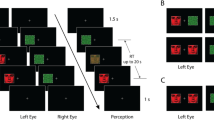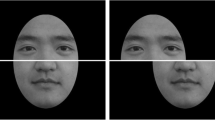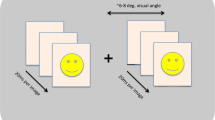Abstract
It is widely acknowledged that holistic processing is a key characteristic of face perception. Although holistic processing implies the automatic integration of face parts, it is unclear whether such processing requires the awareness of face parts. Here, we investigated the interactions between visible face parts and face parts rendered invisible using continuous flash suppression (CFS). In the first experiment with the upper half-face visible and the lower half-face invisible, the results showed that perceived face identity was influenced by the invisible lower half-face, suggesting that integration occurs between the visible and invisible face parts, a variant of the “composite face effect”. In the second experiment, we investigated the influence of visible face parts on the processing of invisible face parts, as measured by the time it took for the invisible parts to break out from CFS. The results showed a visible-to-invisible facilitation effect, that the aligned invisible face parts broke through CFS faster than when the visible and invisible face parts were misaligned. Visible eyes had a stronger influence on the invisible nose/mouth than the other way around. Such facilitation of processing from visible to invisible parts was also found when Chinese characters were used as stimuli. These results show that information integration occurs across the consciousness boundary.






Similar content being viewed by others
References
Koch C. The quest for consciousness: A neurobiological approach, 1st ed. New York: Roberts and Company Publishers, 2004.
Marcel AJ. Conscious and unconscious perception: Experiments on visual masking and word recognition. Cogn Psychol 1983, 15: 197–237.
Halligan PW, Marshall JC. Focal and global attention modulate the expression of visuo-spatial neglect: A case study. Neuropsychologia 1994, 32: 13–21.
Fang F, He S. Cortical responses to invisible objects in the human dorsal and ventral pathways. Nat Neurosci 2005, 8: 1380–1385.
Cho S, He S. Size-invariant but location-specific object-viewpoint adaptation in the absence of awareness. Cognition 2019, 192: 104035.
Montaser-Kouhsari L, Moradi F, Zandvakili A, Esteky H. Orientation-selective adaptation during motion-induced blindness. Perception 2004, 33: 249–254.
Rajimehr R. Unconscious orientation processing. Neuron 2004, 41: 663–673.
Pearson J, Clifford CW. Suppressed patterns alter vision during binocular rivalry. Curr Biol 2005, 15: 2142–2148.
Harris JJ, Schwarzkopf DS, Song C, Bahrami B, Rees G. Contextual illusions reveal the limit of unconscious visual processing. Psychol Sci 2011, 22: 399–405.
Jiang Y, He S. Cortical responses to invisible faces: Dissociating subsystems for facial-information processing. Curr Biol 2006, 16: 2023–2029.
Jiang Y, Costello P, He S. Processing of invisible stimuli: Advantage of upright faces and recognizable words in overcoming interocular suppression. Psychol Sci 2007, 18: 349–355.
Clifford CW, Harris JA. Contextual modulation outside of awareness. Curr Biol 2005, 15: 574–578.
Mareschal I, Clifford CW. Dynamics of unconscious contextual effects in orientation processing. Proc Natl Acad Sci USA 2012, 109: 7553–7558.
Nakashima Y, Sugita Y. Size-contrast illusion induced by unconscious context. J Vis 2018, 18: 16.
Biderman D, Shir Y, Mudrik L. B or 13? unconscious top-down contextual effects at the categorical but not the lexical level. Psychol Sci 2020, 31: 663–677.
Bukach CM, Gauthier I, Tarr MJ. Beyond faces and modularity: The power of an expertise framework. Trends Cogn Sci 2006, 10: 159–166.
Farah MJ, Wilson KD, Drain M, Tanaka JN. What is “special” about face perception? Psychol Rev 1998, 105: 482–498.
Richler JJ, Cheung OS, Gauthier I. Holistic processing predicts face recognition. Psychol Sci 2011, 22: 464–471.
Tanaka JW, Simonyi D. The “parts and wholes” of face recognition: A review of the literature. Q J Exp Psychol (Hove) 2016, 69: 1876–1889.
Rossion B. Picture-plane inversion leads to qualitative changes of face perception. Acta Psychol (Amst) 2008, 128: 274–289.
Boremanse A, Norcia AM, Rossion B. An objective signature for visual binding of face parts in the human brain. J Vis 2013, 13: 6.
Young AW, Hellawell D, Hay DC. Configurational information in face perception. Perception 2013, 42: 1166–1178.
Axelrod V, Rees G. Conscious awareness is required for holistic face processing. Conscious Cogn 2014, 27: 233–245.
Tso RVY, Au TKF, Hsiao JHW. The influence of writing experiences on holistic processing in Chinese character recognition. i-Perception 2011, 2: 345.
Axelrod V, Bar M, Rees G. Exploring the unconscious using faces. Trends Cogn Sci 2015, 19: 35–45.
Faul F, Erdfelder E, Lang AG, Buchner A. G*Power 3: A flexible statistical power analysis program for the social, behavioral, and biomedical sciences. Behav Res Methods 2007, 39: 175–191.
Tsuchiya N, Koch C. Continuous flash suppression reduces negative afterimages. Nat Neurosci 2005, 8: 1096–1101.
Brainard DH. The psychophysics toolbox. Spat Vis 1997, 10: 433–436.
Rossion B. The composite face illusion: A whole window into our understanding of holistic face perception. Vis Cogn 2013, 21: 139–253.
Dienes Z. Bayesian versus orthodox statistics: Which side are You on? Perspect Psychol Sci 2011, 6: 274–290.
Prins N, Kingdom FAA. Applying the model-comparison approach to test specific research hypotheses in psychophysical research using the palamedes toolbox. Front Psychol 2018, 9: 1250.
Wagenmakers EJ, Love J, Marsman M, Jamil T, Ly A, Verhagen J. Bayesian inference for psychology. Part II: Example applications with JASP. Psychon Bull Rev 2018, 25: 58–76.
Hassin RR. Yes it can: On the functional abilities of the human unconscious. Perspect Psychol Sci 2013, 8: 195–207.
Hesselmann G, Moors P. Definitely maybe: Can unconscious processes perform the same functions as conscious processes? Front Psychol 2015, 6: 584.
Moors P, Hesselmann G, Wagemans J, van Ee R. Continuous flash suppression: Stimulus fractionation rather than integration. Trends Cogn Sci 2017, 21: 719–721.
Moors P, Gayet S, Hedger N, Stein T, Sterzer P, van Ee R, et al. Three criteria for evaluating high-level processing in continuous flash suppression. Trends Cogn Sci 2019, 23: 267–269.
Sklar AY, Deouell LY, Hassin RR. Integration despite fractionation: Continuous flash suppression. Trends Cogn Sci 2018, 22: 956–957.
Mudrik L, Faivre N, Koch C. Information integration without awareness. Trends Cogn Sci 2014, 18: 488–496.
Rabagliati H, Robertson A, Carmel D. The importance of awareness for understanding language. J Exp Psychol Gen 2018, 147: 190–208.
Moors P, Hesselmann G. A critical reexamination of doing arithmetic nonconsciously. Psychon Bull Rev 2018, 25: 472–481.
Moors P, Boelens D, van Overwalle J, Wagemans J. Scene integration without awareness: No conclusive evidence for processing scene congruency during continuous flash suppression. Psychol Sci 2016, 27: 945–956.
Reicher GM. Perceptual recognition as a function of meaninfulness of stimulus material. J Exp Psychol 1969, 81: 275–280.
Rossion B, Boremanse A. Nonlinear relationship between holistic processing of individual faces and picture-plane rotation: Evidence from the face composite illusion. J Vis 2008, 8(3): 1–313.
Hung SM, Nieh CH, Hsieh PJ. Unconscious processing of facial attractiveness: Invisible attractive faces orient visual attention. Sci Rep 2016, 6: 37117.
Nakamura K, Kawabata H. Preferential access to awareness of attractive faces in a breaking continuous flash suppression paradigm. Conscious Cogn 2018, 65: 71–82.
Walker-Smith GJ, Gale AG, Findlay JM. Eye movement strategies involved in face perception. Perception 2013, 42: 1120–1133.
Wu EX, Laeng B, Magnussen S. Through the eyes of the own-race bias: Eye-tracking and pupillometry during face recognition. Soc Neurosci 2012, 7: 202–216.
Guastella AJ, Mitchell PB, Dadds MR. Oxytocin increases gaze to the eye region of human faces. Biol Psychiatry 2008, 63: 3–5.
Schurgin MW, Nelson J, Iida S, Ohira H, Chiao JY, Franconeri SL. Eye movements during emotion recognition in faces. J Vis 2014, 14: 14.
Hsiao JHW, Shillcock R. Analysis of a Chinese phonetic compound database: Implications for orthographic processing. J Psycholinguist Res 2006, 35: 405–426.
Acknowledgements
This work was supported by a Key Research Program of Frontier Sciences ( KJZD-SW-L08), Strategy Priority Research Program of Chinese Academy of Science ( XDB32020200), and the Beijing Municipal Science & Technology Commission (Z181100001518002).
Author information
Authors and Affiliations
Corresponding author
Ethics declarations
Conflict of interest
The authors claim that there are no conflicts of interest.
Rights and permissions
About this article
Cite this article
Ren, S., Shao, H. & He, S. Interaction Between Conscious and Unconscious Information-Processing of Faces and Words. Neurosci. Bull. 37, 1583–1594 (2021). https://doi.org/10.1007/s12264-021-00738-0
Received:
Accepted:
Published:
Issue Date:
DOI: https://doi.org/10.1007/s12264-021-00738-0




